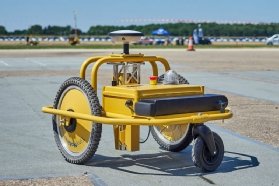
Highways England uses robot to speed up roadworks
A machine equipped with precise positioning technology carried out, in a few hours, road marking work that usually takes a week
Highways England claims to have saved “hundreds of hours of working time” and increased worker safety by using a robot to support the job of painting new or resurfaced roads.
The machine, equipped with precise positioning technology, marks out where white lines need to be painted. In four hours, the robot pre-marked eight miles of the M6 in Staffordshire, a project that would take two engineers more than a week to complete.
The WJ Robotic PreMarker is being used in various Highways England projects, including the UK’s biggest road upgrade, the £1.5bn A14 Cambridge-to-Huntingdon improvement.
According to the agency, the robot has saved 27 hours of working time marking three miles of hard shoulder on the M4 in Berkshire, 77 hours covering five miles of the M6 in Warwickshire, and six hours working on two miles of the M1 in Leicestershire. Further work was done on the M60 smart motorway at Manchester.
As well as saving working time, Highways England said the robot also delivers safety benefits for roadworkers – the agency calculates that about 250 drivers illegally drive into roadworks every month – and reduces the risk of back injuries to workers caused by bending down to pre-mark roads by hand. The equipment also enables staff to focus on other essential work to complete various projects, and boosts accuracy, it said.
Julian Lamb, construction director on the A14, where the robot has been used, said: “With safety our top priority, the time savings the robot can provide, coupled with removing our operatives from a potentially hazardous situation, make it a great solution.”

Highways England is also completing a pilot that started in early 2019 with a self-driving dump truck on the Cambridge-Huntingdon improvement to reduce the amount of time spent on the project.
The vehicle, used in a controlled environment, is being employed to transport excavated soil to fill large areas. It is programmed remotely to follow a predetermined route and can detect and avoid obstacles and other vehicles along the route as it drives.
Lamb added: “These technologies are also supporting new jobs, with the engineers of tomorrow needing to learn new skills, such as programming this autonomous equipment.”
Read more about autonomous vehicles
- The Port of Rotterdam is creating an environment where autonomous ships will become the norm, through IoT and IBM Watson.
- When AIs go to war: Autonomous cyber weapons ‘inevitable’.
- Swedish ferry operator Stena Line plans to cut costs and become more environmentally friendly by operating autonomous ships.











